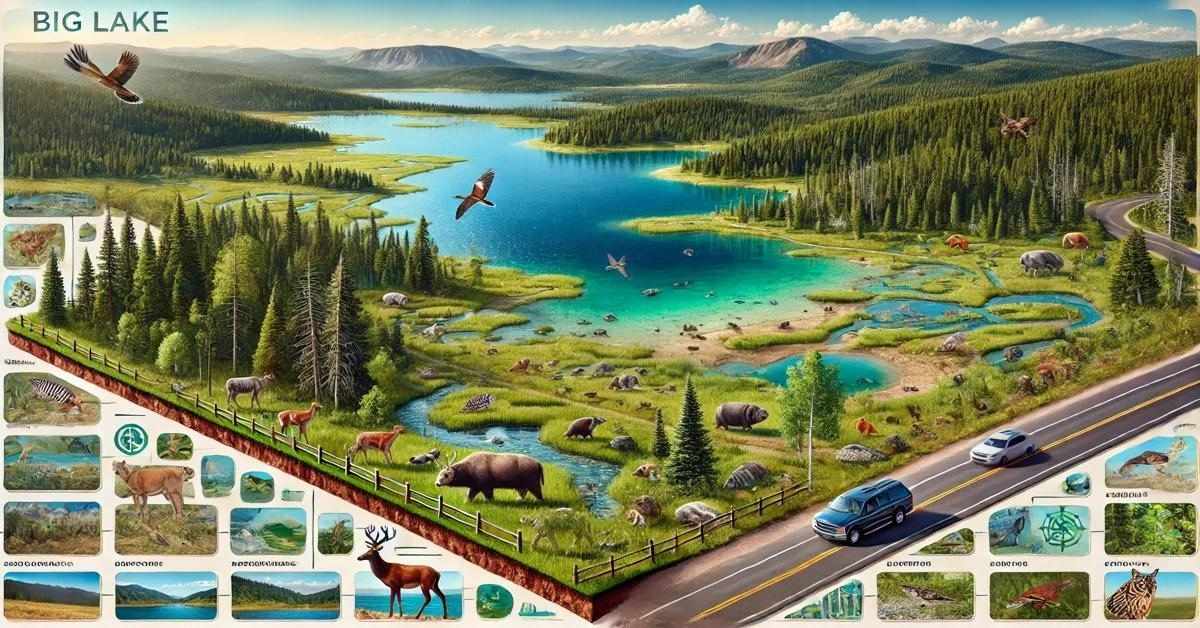Introduction
Nestled in the Apache-Sitgreaves National Forests of northeastern Arizona, Big Lake Arizona is a breathtaking freshwater body renowned for its stunning natural beauty, diverse wildlife, and recreational opportunities. With an elevation of approximately 7,600 feet, the lake and its surroundings boast a unique ecosystem characterized by lush forests, meadows, and mountainous terrain. Big Lake Arizona is not only a vital habitat for various species but also a popular destination for outdoor enthusiasts seeking fishing, boating, hiking, and wildlife-viewing experiences.
This article aims to delve into the ecological significance of Big Lake Arizona, exploring its formation, biodiversity, water quality, the challenges it faces from human activities and climate change, and ongoing conservation efforts. By examining these aspects, we can foster a greater appreciation for Big Lake Arizona and highlight the importance of sustainable practices to protect this valuable ecosystem.
1. Geographic and Ecological Overview of Big Lake Arizona, Arizona
Big Lake Arizona is situated in the White Mountains of Arizona, a region characterized by its rich biodiversity and varied landscapes. Understanding the geography and ecology of Big Lake Arizona is essential for appreciating its ecological significance.
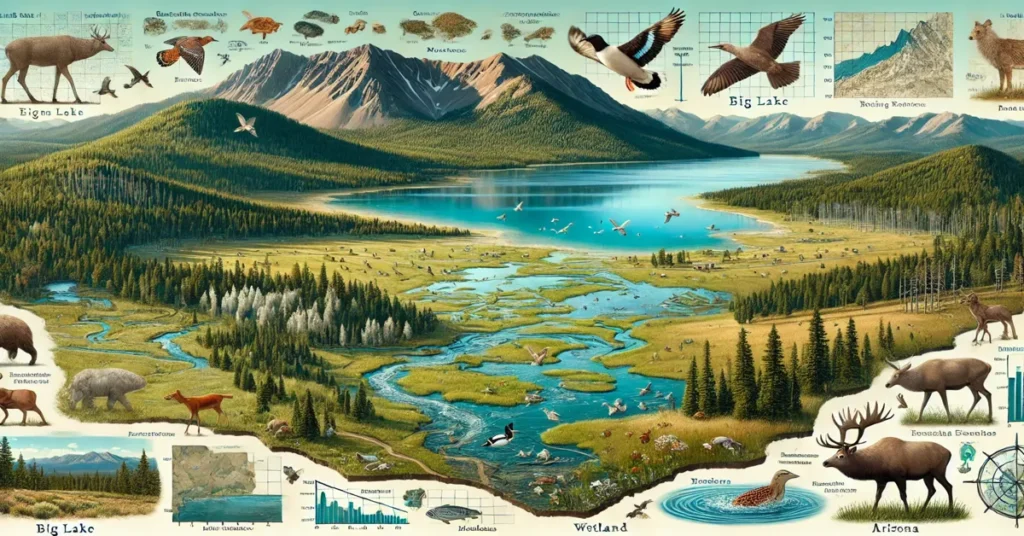
1.1. Geographic Features
- Location: Big Lake Arizona is located in Apache County, within the Apache-Sitgreaves National Forests. The lake lies approximately 25 miles southwest of the town of Springerville and is accessible via forest roads.
- Size and Depth: Big Lake Arizona covers an area of about 500 acres and has an average depth of 15 feet, with some areas reaching depths of up to 30 feet. Its size and depth make it an ideal habitat for various aquatic species.
- Elevation and Climate: At an elevation of around 7,600 feet, Big Lake Arizona experiences a unique climate with cooler temperatures compared to lower elevations in Arizona. The region receives substantial snowfall in winter and has a growing season of about 90 days.
1.2. Ecological Characteristics
The ecological characteristics of Big Lake Arizona and its surrounding areas contribute to its biodiversity and overall health.
- Water Source: Big Lake Arizona is primarily fed by snowmelt from the surrounding mountains, as well as runoff from rain. This consistent water source helps maintain the lake’s water levels and quality.
- Surrounding Ecosystems: The lake is surrounded by diverse ecosystems, including ponderosa pine forests, mixed conifer forests, and high mountain meadows. These habitats support a variety of wildlife and plant species.
2. Biodiversity in Big Lake Arizona, Arizona
Big Lake Arizona is home to a rich array of flora and fauna, contributing to its ecological importance. The lake and its surrounding ecosystems support various species that rely on the habitat for survival.

2.1. Aquatic Life
The aquatic ecosystems of Big Lake Arizona are diverse, supporting numerous species of fish, invertebrates, and aquatic plants.
- Fish Species: Big Lake Arizona is well-known for its fishing opportunities, particularly for species such as rainbow trout, brook trout, and tiger trout. The lake is stocked with trout by the Arizona Game and Fish Department, attracting anglers from all over the region.
- Aquatic Invertebrates: The lake’s ecosystem includes various aquatic invertebrates, such as insects, crustaceans, and mollusks, which play vital roles in the food web. These organisms contribute to nutrient cycling and provide food for fish and other wildlife.
2.2. Terrestrial Flora and Fauna
The diverse habitats surrounding Big Lake Arizona are home to a wide range of plant and animal species.
- Vegetation: The forests surrounding Big Lake Arizona are dominated by species such as ponderosa pine, white fir, and aspen. These trees provide essential habitat for numerous bird and mammal species.
- Wildlife: Big Lake Arizona and its surrounding areas support a variety of wildlife, including deer, elk, black bears, coyotes, and numerous bird species. The presence of these animals contributes to the ecological balance of the region.
3. Ecological Importance of Big Lake Arizona, Arizona
Big Lake Arizona plays a crucial role in maintaining ecological balance and supporting biodiversity in the region. Its significance extends beyond its beauty, providing essential ecosystem services.
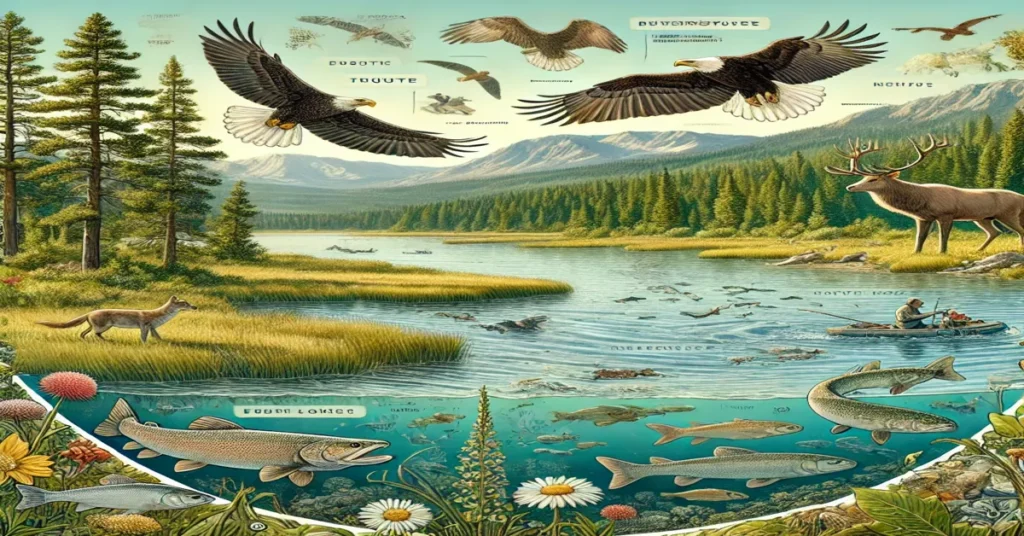
3.1. Water Quality and Filtration
Big Lake Arizona contributes to water quality and ecosystem health through natural filtration processes.
- Nutrient Cycling: The lake’s aquatic plants and microorganisms help cycle nutrients, breaking down organic matter and preventing excessive nutrient buildup that can lead to harmful algal blooms.
- Water Filtration: The sediments and vegetation in Big Lake Arizona act as natural filters, removing pollutants and sediments from the water. This filtration process is essential for maintaining healthy aquatic ecosystems.
3.2. Habitat for Wildlife
Big Lake Arizona serves as a critical habitat for various species, supporting both aquatic and terrestrial life. for their environment. Field trips to Big Lake Arizona can offer hands-on learning experiences and encourage students to engage in conservation efforts.
- Community Workshops: Workshops and seminars can educate residents about sustainable practices, water conservation, and the importance of protecting local ecosystems.
3.3. Recreational Opportunities
Big Lake Arizona offers a range of recreational opportunities that contribute to local economies and promote outdoor activities.
- Fishing and Boating: The lake attracts anglers and boaters, providing opportunities for recreation and relaxation. These activities can foster a connection to nature and raise awareness about the importance of conservation.
- Hiking and Wildlife Viewing: The surrounding areas offer hiking trails and wildlife viewing opportunities, allowing visitors to experience the beauty of the region and appreciate its ecological significance.
4. Challenges Facing Big Lake Arizona
Despite its ecological importance, Big Lake Arizona faces numerous challenges from human activities, climate change, and environmental degradation. Understanding these challenges is crucial for implementing effective conservation measures.
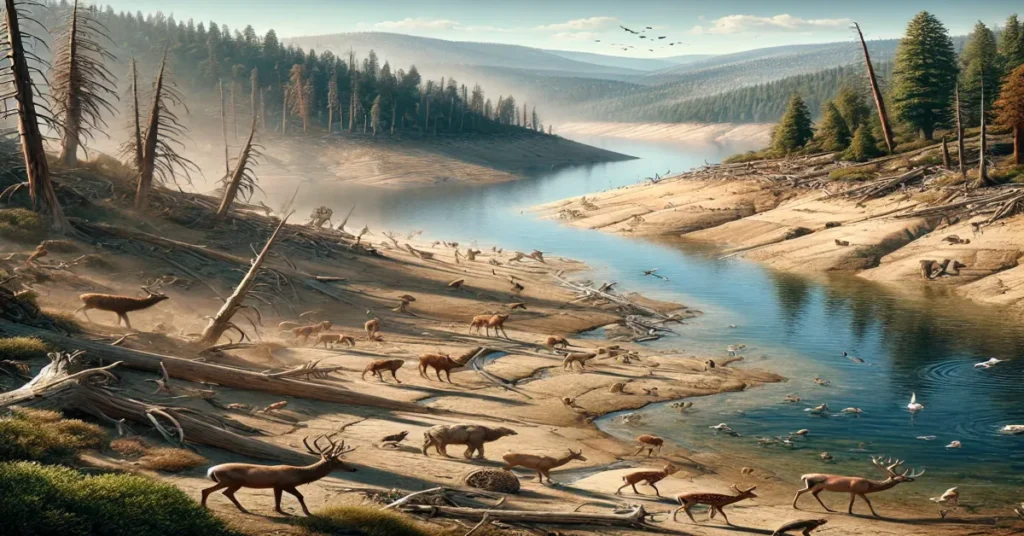
4.1. Water Quality Concerns
Water quality is a significant issue for Big Lake , with various factors impacting its health.
- Nutrient Pollution: Nutrient runoff from agricultural and urban areas can introduce excess nitrogen and phosphorus into the lake. This nutrient influx can lead to algal blooms, depleting oxygen levels and harming aquatic life.
- Pollutants: Chemical contaminants, such as pesticides and heavy metals, can enter the lake through runoff and negatively impact water quality. Monitoring and managing these pollutants is essential for preserving the health of the lake.
4.2. Habitat Loss and Degradation
Human activities can lead to habitat loss and degradation, threatening the ecological integrity of Big Lake Arizona.
- Development Pressure: Increased development around the lake, including housing and infrastructure projects, can fragment habitats and disrupt local ecosystems. This development can lead to the loss of critical wildlife habitat.
- Invasive Species: The introduction of invasive species can threaten native flora and fauna. Invasive plants and animals often outcompete native species for resources, disrupting the ecological balance.
4.3. Climate Change
Climate change poses significant threats to Big Lake Arizona and its surrounding ecosystems.
- Temperature Increases: Rising temperatures can alter the distribution of plant and animal species, impacting the ecological balance of the region. Some species may struggle to adapt to changing conditions, leading to population declines.
- Altered Precipitation Patterns: Changes in rainfall patterns can affect water availability for Big Lake Arizona, impacting biodiversity and habitat health. Droughts can reduce water levels, while heavy rainfall can lead to flooding and erosion.
5. Conservation Efforts for Big Lake Arizona
To address the challenges facing Big Lake Arizona, various conservation efforts have been implemented to protect its ecosystems and biodiversity. These initiatives involve collaboration among government agencies, non-profit organizations, local communities, and researchers.
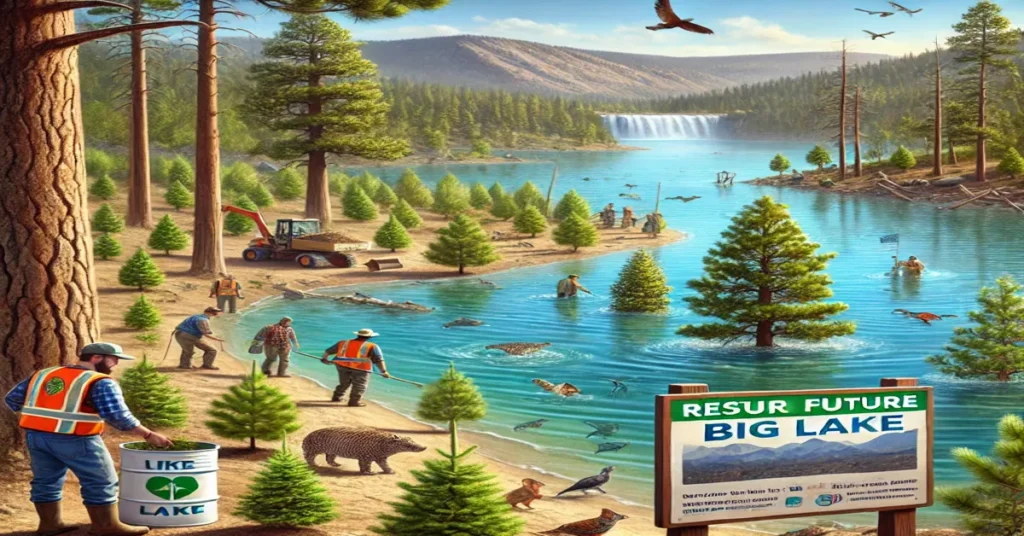
5.1. Water Quality Monitoring
Regular monitoring of water quality is essential for understanding the health of Big Lake and identifying potential issues.
- Data Collection: Government agencies and environmental organizations often conduct water quality assessments to measure parameters such as nutrient levels, temperature, and dissolved oxygen. This data helps inform management decisions and conservation strategies.
- Community Involvement: Citizen science initiatives encourage local residents to participate in water quality monitoring efforts. Engaging the community fosters a sense of stewardship and raises awareness about the importance of protecting Big Lake Arizona.
5.2. Habitat Restoration
Restoration projects aim to improve the health and resilience of Big Lake Arizona and its surrounding habitats.
- Wetland Restoration: Efforts to restore wetlands can enhance habitat availability for wildlife and improve water quality. Restored wetlands serve as natural buffers, filtering pollutants and absorbing excess nutrients before they enter the lake.
- Invasive Species Management: Programs to manage and control invasive species are essential for protecting native biodiversity. This may involve removing invasive plants, implementing monitoring programs, and restoring native vegetation.
5.3. Sustainable Land Use Practices
Promoting sustainable land use practices around Big Lake Arizona is essential for minimizing human impact on these ecosystems.
- Best Management Practices (BMPs): Implementing BMPs in agricultural and urban areas can reduce nutrient runoff and minimize pollution. These practices may include buffer strips, cover crops, and proper waste management.
- Zoning Regulations: Local governments can establish zoning regulations that protect sensitive habitats and limit development near Big Lake Arizona. These regulations can help preserve the natural landscape and maintain ecological integrity.
6. Community Engagement and Education
Community involvement is vital for the successful conservation of Big Lake Arizona. Educating local residents about the importance of this ecosystem can foster a culture of stewardship and promote sustainable practices.

6.1. Educational Programs
Environmental education programs can provide valuable information about Big Lake Arizona and its ecological significance.
- School Initiatives: Incorporating lessons about local ecosystems into school curricula can help students develop an appreciation providing visitors with access to stunning landscapes and a chance to connect with nature.
7. The Role of Policy and Governance in Protecting Big Lake Arizona
Effective policy and governance are essential for the conservation and protection of Big Lake. Collaborative approaches involving various stakeholders can enhance the sustainability of this vital ecosystem.

7.1. Regulatory Frameworks
Establishing regulatory frameworks to protect water quality, habitat, and biodiversity is crucial for the health of Big Lake Arizona.
- Water Quality Standards: Governments can implement water quality standards to regulate pollutant discharges into the lake. These regulations help ensure the health of aquatic ecosystems and protect human health.
- Land Use Planning: Zoning regulations can help prevent harmful land use practices near Big Lake Arizona, minimizing habitat loss and pollution. Effective land use planning promotes sustainable development while safeguarding natural resources.
7.2. Collaborative Governance
Collaborative governance approaches that engage stakeholders at all levels can enhance the management of Big Lake Arizona.
- Cross-Agency Coordination: Coordinated efforts between different government agencies can lead to more effective conservation strategies. Collaboration can streamline regulations, share resources, and enhance the implementation of conservation initiatives.
- Partnerships with Indigenous Communities: Working with Indigenous communities that have deep connections to the land can enhance conservation efforts. Incorporating traditional ecological knowledge into conservation practices can provide valuable insights and promote sustainable management of Big Lake Arizona.
8. The Cultural Significance of Big Lake Arizona, Arizona
Beyond its ecological importance, Big Lake Arizona holds cultural significance for local communities. Understanding this cultural context enhances our appreciation for the area and emphasizes the need for its protection.

8.1. Recreation and Tourism
Big Lake Arizona serves as a popular destination for recreational activities, attracting visitors from nearby towns and cities.
- Fishing and Boating: The lake is well-known for its fishing opportunities, with many anglers seeking to catch trout and other fish species. Boating and kayaking are also popular activities, allowing visitors to explore the scenic beauty of the lake.
- Camping and Hiking: The surrounding Apache-Sitgreaves National Forest offers camping and hiking opportunities, p
- Breeding and Feeding Grounds: The lake provides essential breeding and feeding grounds for numerous species, including migratory birds that rely on the lake for nesting and feeding during their journeys.
- Biodiversity Support: The diverse ecosystems surrounding Big Lake Arizona support a rich array of species, contributing to the overall health of the region. Maintaining biodiversity is essential for ecosystem resilience.
8.2. Historical Significance
The region around Big Lake Arizona has a rich history, with ties to Indigenous cultures and early settlers.
- Indigenous Heritage: The lands surrounding Big Lake are traditional territories for Indigenous peoples, including the Apache and Navajo tribes. These communities have deep cultural ties to the land, and their traditional knowledge can inform conservation efforts.
- Early Settlements: The area was also inhabited by early European settlers, who relied on its resources for survival. Understanding the historical context of Big Lake adds depth to its cultural significance and highlights the importance of protecting its legacy.
Conclusion: The Importance of Protecting Big Lake Arizona
Big Lake Arizona, is a vital ecological resource that provides essential services and supports a rich tapestry of life. Its unique landscapes, diverse ecosystems, and cultural significance make it imperative to prioritize its conservation and sustainable management. By understanding the challenges it faces and implementing effective strategies, we can ensure that Big Lake Arizona remains a thriving ecosystem for generations to come.
As we reflect on the beauty and importance of this natural treasure, let us commit to fostering a deeper appreciation for Big Lake and taking action to protect the environments that enrich our lives. Through collaboration, education, and advocacy, we can create a sustainable future for Big Lake Arizona, ensuring that it continues to provide ecological benefits and recreational opportunities for all. Together, we can safeguard this remarkable landscape and the intricate web of life it supports.
Read More: Dragon’s Teeth Maui: The Environmental Niche of a Geological Wonder

